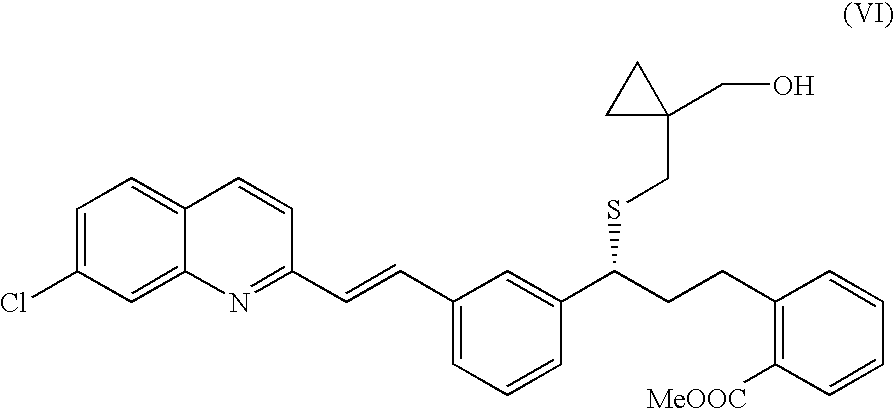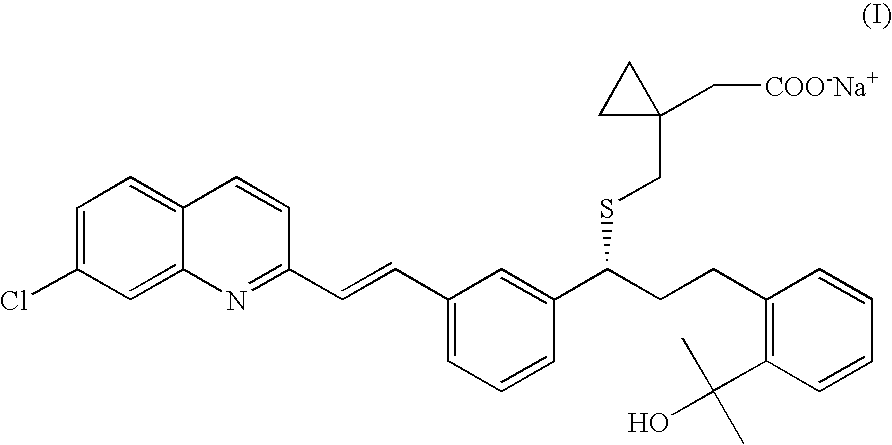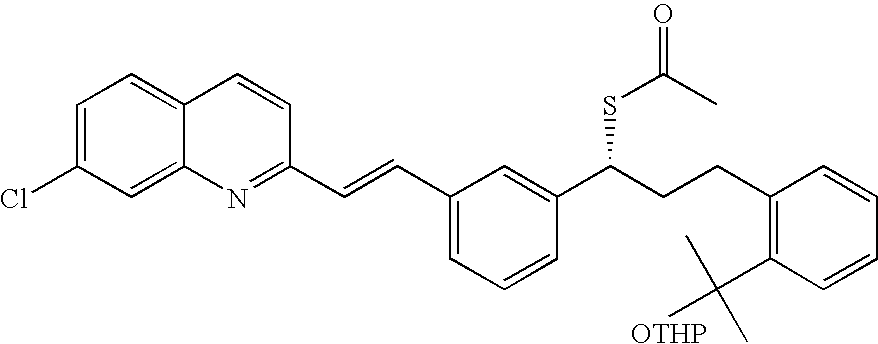Process for the Preparation of a Leukotriene Antagonist and Intermediates Thereof
a technology of leukotriene antagonist and intermediate, which is applied in the direction of blood disorder, extracellular fluid disorder, digestive system, etc., can solve the problems of low yield of intermediate and final product, and the process is not particularly suitable for large-scale production, and achieves high chemical and optical purity, cost-effective effect, and suited to scale up
- Summary
- Abstract
- Description
- Claims
- Application Information
AI Technical Summary
Benefits of technology
Problems solved by technology
Method used
Image
Examples
example 1
Preparation of S-(1-(hydroxymethyl)cyclopropyl)methyl ethanethioate (X)
[0036]200 g of 5,7-dioxa-6-thiaspiro[2.5]octane 6-oxide were dissolved in 1.2 l of dimethyl sulfoxide and 308 g of potassium ethanethioate were poured to the solution. Then, the suspension was heated at 40° C. for 5. Once the reaction was completed, a combination of 3.6 l of ethyl acetate and 3.61 of water was added. The organic phase was separated, washed with water and concentrated to dryness. 200 g of S-(1-(hydroxymethyl)cyclopropyl)methyl ethanethioate were recovered. Yield: 78% corrected by GC. 1H NMR (400 MHz, CDCl3): 3.45 (2H, d, J: 6.4 Hz); 3.01 (2H, s); 2.53 (OH, broad triplet, J: 6.4 Hz); 2.39 (3H, s); 0.54 (4H, m).
example 2
Preparation of (1-(mercaptomethyl)cyclopropyl)methanol (VIII)
[0037]200 g of S-(1-(hydroxymethyl)cyclopropyl)methyl ethanethioate were dissolved in 2 l of methanol. Then, 111 ml of concentrated HCl were added under a nitrogen blanket and the solution was stirred at room temperature for 10. The solvent was distilled off and the residue was re-dissolved in 1.5 l of dimethylformamide to be used in the preparation of methyl 2-((R)-3-(3-((E)-2-(7-chloroquinolin-2-yl)vinyl)phenyl)-3-(((1-(hydroxymethyl)cyclopropyl)methyl)sulfanyl)propyl)benzoate. Yield: 100%. 1H NMR (400 MHz, CDCl3): 3.57 (2H, s); 2.63 (2H, d, J: 8.0 Hz); 2.45 (OH, broad signal,); 1.43 (5H, t, J: 8.0 Hz); 0.52 (4H, m).
example 3
Preparation of methyl 2-((S)-3-(3-((E)-2-(7-chloroquinolin-2-yl)vinyl)phenyl)-3-[(methylsulfonyl)oxy]propyl)benzoate (VII with R2: CH3)
[0038]12.1 ml de diisopropylethylamine were poured to a stirred solution of 24.5 g of methyl 2-((S)-3-(3-((E)-2-(7-chloroquinolin-2-yl)vinyl)phenyl)-3-hydroxypropyl)benzoate in 120 ml of dichloromethane. The mixture is cooled to −20° C. and 5 ml of mesyl chloride were added slowly. Once the reaction was completed, the crude solution was successively washed with 120 ml of an aqueous 10% NaHCO3 solution and 120 ml of water. Finally, the solvent was distilled off to obtain 29 g of the title compound. The product was re-dissolved in 290 ml of dimethylformamide to be used as a solution in the next step. Yield: 100%.
PUM
| Property | Measurement | Unit |
|---|---|---|
| temperature | aaaaa | aaaaa |
| temperature | aaaaa | aaaaa |
| temperature | aaaaa | aaaaa |
Abstract
Description
Claims
Application Information
 Login to View More
Login to View More - R&D Engineer
- R&D Manager
- IP Professional
- Industry Leading Data Capabilities
- Powerful AI technology
- Patent DNA Extraction
Browse by: Latest US Patents, China's latest patents, Technical Efficacy Thesaurus, Application Domain, Technology Topic, Popular Technical Reports.
© 2024 PatSnap. All rights reserved.Legal|Privacy policy|Modern Slavery Act Transparency Statement|Sitemap|About US| Contact US: help@patsnap.com










